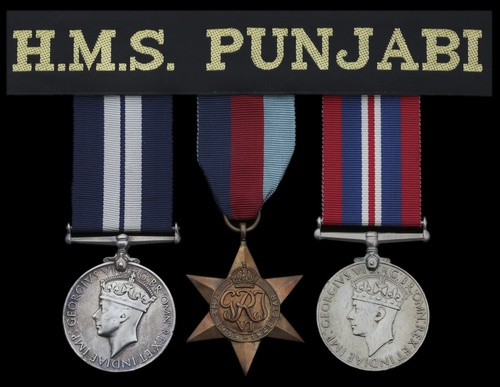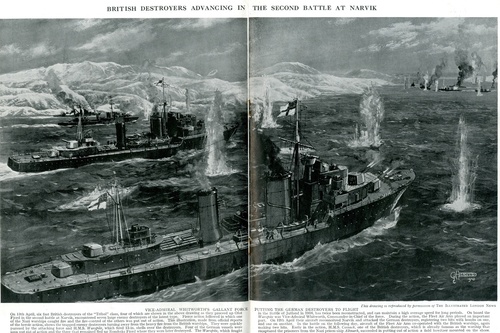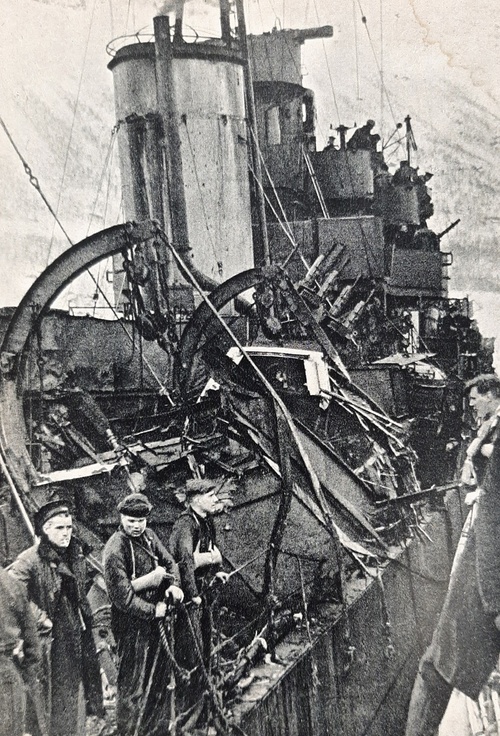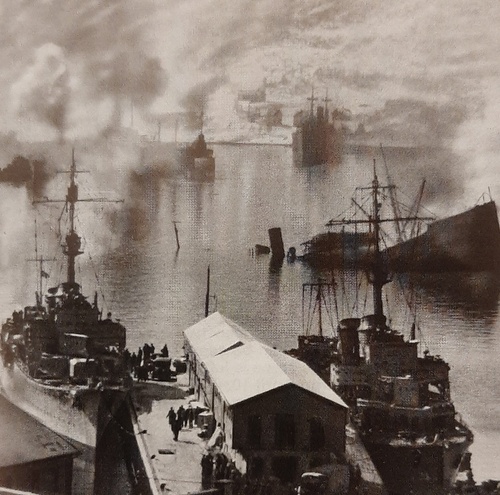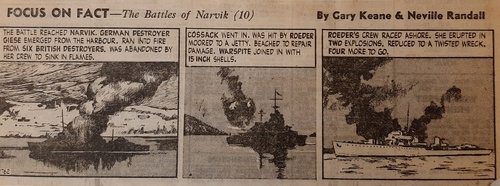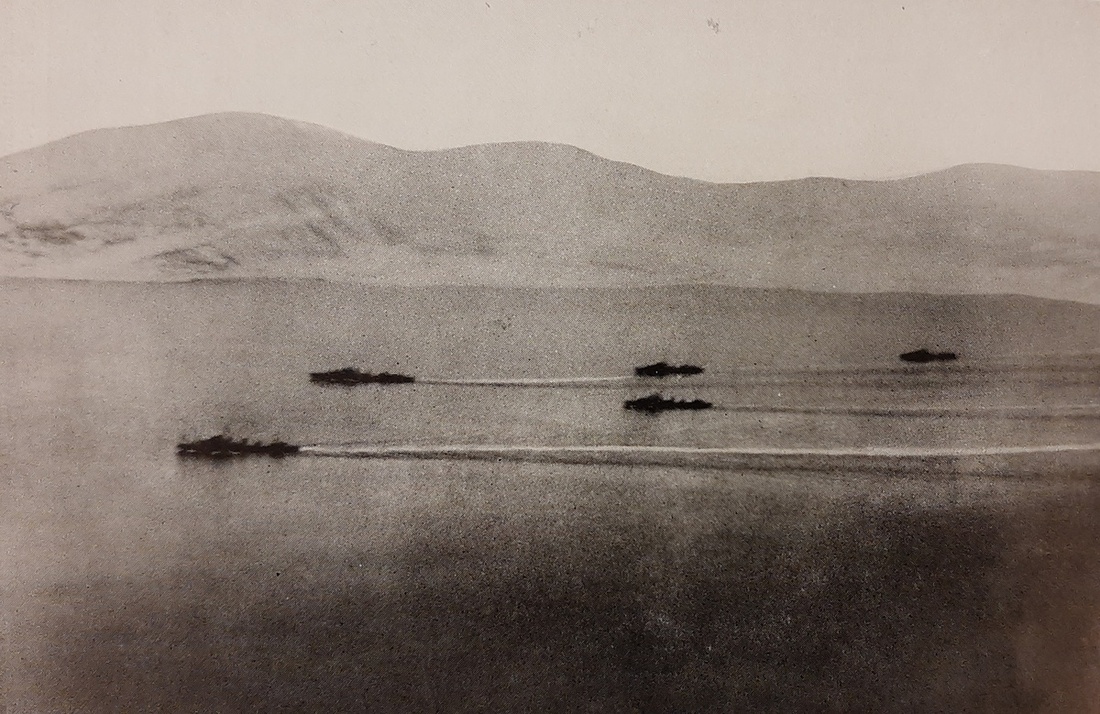Auction: 22075 - Orders, Decorations and Medals
Lot: 111
'The British destroyers had not escaped unscathed. On the Punjabi had fallen a fierce and accurate rain of 5-inch shells. The first, plunging into her hull below the bridge, had burst between decks, splinters killing one man and wounding three others in the transmitting station whence the guns were controlled. While two of these were having their wounds dressed on the mess deck nearby they were more seriously injured by a second shell which had burst on the upper deck at the foot of a steel locker containing ready-use cordite charges for the guns. Tearing a hole in the deck, it had showered splinters between decks killing two of the ammunition supply party and wounding others. Cordite charges from the locker blazed up, starting a fierce fire.
Almost simultaneously, the ship shook to another hit right forward which shattered a watertight bulkhead and caused flooding. A fire then broke out between the funnels from a bursting shell. Right aft another shell had plunged into a storeroom starting a blaze which threatened a magazine which had to be flooded. Fire and repair parties were thus all fully occupied when a fifth hit, bursting on the starboard motor boat and setting it alight, sent a jagged fragment through the upper deck, smashing a steam pipe and engulfing the engine room in a roaring cloud of steam. Other splinters had swept across the decks, killing two of the pom-pom crew and wounding two others as well as three of the torpedo-tubes' crew.'
Narvik by Donald Macintyre, refers.
The superb H.M.S. Punjabi - Battle of Narvik D.S.M. group of three awarded to Able Seaman H. Partridge, Royal Navy who - despite a number of lucky escapes - was twice severely wounded during the famous action
Distinguished Service Medal, G.VI.R. (JX.131446 H. Partridge. A. B. H.M.S. Punjabi.); 1939-45 Star; War Medal 1939-45, polished, contact marks, edge wear, nearly very fine (3)
D.S.M. London Gazette 28 June 1940, the original recommendation states:
'Wounded first in the Transmitting Station, with a shattered right-hand and a shell splinter in the face, he was on the mess-deck on his way in the fore dressing station when a Large splinter from a second shell penetrated his left buttock.
This rating was qualified in First Aid and, suffering from profuse arterial bleeding from the right hand, he most heroically attended his own tourniquet. His persistent cheerfulness and good spirits formed a most courageous example.'
Herbert Partridge lived at Methyr Street, Barry Dock and served as Able Seaman aboard H.M.S. Punjabi during the Second World War. With the German invasion of Norway a British force under Captain B. A. W. Warburton-Lee of the Hardy launched a daring strike against the enemy destroyers in the West Fjord. The First Battle of Narvik was a surprising success for the British though they suffered heavy losses for it, including Warburton-Lee.
When it was realised how weakened the German forces at Narvik were the admiralty swiftly assembled a task force led by Admiral Whitworth aboard H.M.S. Warspite and nine destroys including four tribal class vessels- Punjabi, Cossack, Bedouin and Eskimo. They arrived at the Fjord on 13 April proceeded the day prior by a flight of Swordfish aircraft from H.M.S. Furious.
The official history notes that the weather on 13 April was 'misty, with low clouds and drizzle' meaning that the already difficult task of safely manoeuvring the enormous Warspite in the close fjords was made all the harder. Despite this the force made good progress and were soon spotted by the German picket ship Kunne.
Withdrawing the Kunne hoped to draw the British into a position where they could bring their torpedoes to bear. Unfortunately for them Warspite was carrying a floatplane which was launched to scout ahead and report the enemy disposition. They also succeeded in bombing and sinking U64 as it lay on the surface.
Their information provided warning of Kollner another destroyer lurking in ambush. This prior warning allowed the British destroyers to catch her and- with supporting fire from Warspite- poured fire into her until she rolled over and sank. Some half-hearted skirmishing through the Fjord followed, ending only when the British came within sight of Narvik and found the German Squadron awaiting them.
The British force came into a line with Warspite behind to provide fire support with her heavy 15-inch guns and advanced on the German ships. Overhead Swordfish from Furious again swept in to attack, though in the event they were unable to connect with the enemy.
The German Squadron opened a withering fire into the British vessels which they had little choice but to bear for the present. Fortunately the clash with Warburton-Lee had drained them of ammunition and soon Zenker, Arnim and Kunne were all forced to retire. That is not to say that the fire slackened particularly as one incident aboard Punjabi makes clear:
'A message from the engine room had just reached Commander H. T. Lean, Punjabi's captain, that the engines would shortly have to be stopped owing to the burst pipe, when torpedoes were seen approaching, running on the surface. With imperturbable skill, Lean swerved his ship out of their path, but the time had come to consider what best to do for his ship in its precarious situation. The engineer had been sent for to report on the siutation below. With fires blazing forward, amidships and aft, all fire hoses slashed and useless, extinguishers exhausted, the guns' crews were urgently needed to help the parties fighting the flames by means of buckets of water. The guns were, in any case, in local control and largely ineffective owing to the damage to the transmitting station.
As the engineer officer arrived, oil-streaked, grimy and wild-eyed, a sixth shell burst on the upper deck below, savagely wounding him in the back and arms. He was just able to confirm his diagnosis of the damage to the steam system before collapsing. The chief stoker in charge of the party fighting the fire amidships was instantly killed and several more men wounded.
There was urgent need for a respite in which to get the situation under control. Lean put his wheel over and retired, signalling his predicament to the Admiral. Heroic efforts were then able to master the fires. The steam system was repaired and the magazine pumped out. Within an hour Punjabi was steaming into action again, though her speed was restricted to fifteen knots by the jagged hole in her bows.'
Patridge began the battle in the transmitting station but was seriously wounded when this was hit. The Barry and District News, 16 June 1940, relates the following story:
'Partridge had an amazing escape from death when in the control he saw a shell lying on the floor. He presumed one of the men had dropped it and took no notice. Some time later however, the shell exploded and four of Mr Partridge's fellow sailors in the control were killed.'
Despite the horrific damage meted out the German Squadron was suffering just as much and they were fast running out of ammunition. Cossack was grounded in the harbour as a result of damage to her steering but judicious use of her guns kept the enemy ground forces at bay and the enemy vessels present there were soon put out of commission. Meanwhile the rest of the Squadron hunted the surviving German ships through the narrow waterways that fed into Narvik and West Fjord. Her slow pace meant that Punjabi took little part in these engagements later guarding the heavily damaged Eskimo after her victorious clash with Thiele.
Patridge's wounds were such that he had to be evacuated on Warspite after the fighting. After a turn in two British hospitals he was able to return home to Barry Dock in early June 1940 to the sight of an excited crowd flying flags in welcome; sold together with corresponding dress miniatures and an H.M.S. Punjabi cap title as well as after action reports, recommendation for award and London Gazette entry along with a Focus on Fact cartoon strip, an extract from the Barry and District News and original copies of Narvik, Hutchinson's Pictorial History of the War and After the Battle - The Norwegian Campaign.
Subject to 20% VAT on Buyer’s Premium. For more information please view Terms and Conditions for Buyers.
Sold for
£1,400

